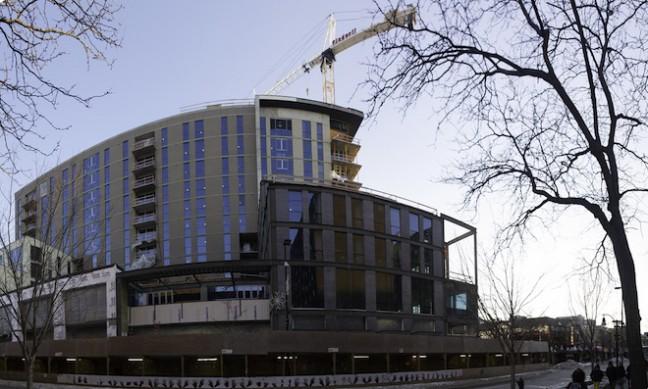Following the construction of State Street’s Hub, a similar housing project from the same company, Core Campus, is in its proposal stage — this time on University Avenue.
The plans for Hub Madison Two, which will be presented to the Urban Design Commission on Feb. 25, denote a 12-story, 1,000 bed upscale student housing property.
There are positive and negative aspects of the new project, Ald. Mike Verveer, District 4, said.
Mayor Paul Soglin, for example, has raised concerns over the changing face of the State Street area over the past few years.
Soglin said he has noticed a decrease in retail shops consistent with an increase in establishments seeking liquor licenses and student housing complexes.
“I’m deeply concerned about the affordability of clothing, books [and] food for the student community as we get more and more liquor licenses in the area,” Soglin said.
Madison’s biggest need right now is affordable housing, Verveer said.
“Overall, there continues to be a very obvious lack of any sort of affordable housing being proposed downtown,” Verveer said. “The Hub developers … in 2013, as they were seeking approval for their first Hub, responded by adding several dozen micro-unit efficiency apartments in their design. So while they’re certainly not spacious at all, they are more affordable.”
Those micro-units are suitable for tenants who want to live alone, Verveer said. However, it is too early in Hub Madison Two’s plans to tell if similar micro-units will be included.
On the positive side, there are many people who want to live downtown, Verveer said. Vacancy rates for both students and downtown residents is extremely low, he said.
“Madison Gas and Electric company has done regular surveys for years based on their utility services to estimate vacancy rates throughout the whole community, and vacancy rates in the downtown area are the lowest they’ve ever been in the history of their surveys,” Verveer said.
MG&E has been conducting rental vacancy rate surveys since 2008, according to the MG&E website.
Vacancy rates have decreased almost by 25 percent since 2008, according to MG&E. Between the months of July and September, vacancy rates have consistently been the highest.
As of December 2014, Madison had a 2.39 percent vacancy rate, which MG&E determines by the percentage of properties appearing to be vacant due to an inactive electric service or if the service is changed to a building owner’s name.
These findings could change due to a crop of new apartments and housing complexes available this upcoming summer, Verveer said. In spite of this, developers are still proposing new housing options due to studies showing a need for more living space downtown.
Hub Madison Two will fit the right amount of tenants for the zoning code for this part of town, Verveer said. The proposal is based on the city’s current allowance of space, which is not seen as a positive aspect to everyone.
“Some already feel there is a canyon, with all the new buildings on Gorham and Johnson and University Avenue, and this will just add to that,” Verveer said. “This is a very large building in height and mass. Over the years, people have mention they don’t appreciate all the buildings [downtown], but the city, they’ve had a policy for many years to keep tall buildings generally in one area.”
In the 1990s, there were very few student housing high-rises downtown, Verveer said, but now, there are more tools available to developers to build student housing.













